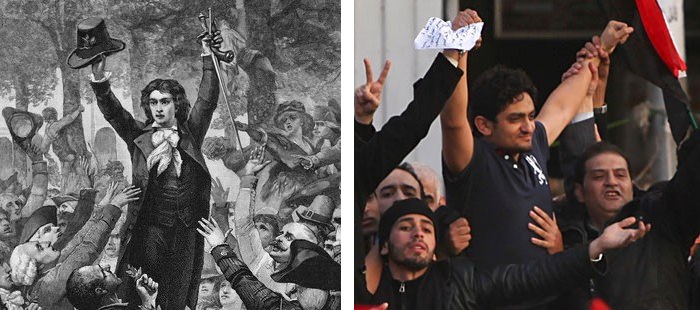The question has come to haunt every article and broadcast from Egypt, Tunisia and other countries in the region whose people have revolted: what constitutes a revolution? In the 1970s, we used to chase that question in courses on comparative revolutions; and looking back on my ancient lecture notes, I can’t help but imagine a trajectory: England, 1640; France, 1789; Russia, 1917 … and Egypt, 2011?
I would not presume to pronounce on the course of events in Egypt over the past three weeks, but I think it’s fair to ask whether the information that now arrives every second by every means of communication from Twitter to television bears any relation to the classic models of revolution. Or should Egypt teach us to abandon those models altogether and to consider a kind of upheaval undreamt of in our old varieties of political science?
From the perspective of the 1970s, France produced the mother of all revolutions in the 1780s; and we saw proto-typical phases in the French experience: the collapse of the old order, a period of constitutional reconstruction, counter-revolution, radicalization, terror, reaction, and a military dictatorship. If the events in Egypt fit that pattern, they have barely entered phase one, and have far to go.
But why should they fit? Perhaps as some historians used to argue, the pattern expresses a deeper dialectic, which can be detected in every great upheaval. Yet others argued back by citing elements that were unique to particular situations, such as bungled leadership, unforeseen consequences, and sheer contingency. The element of contingency certainly weighed heavily in 1789. If Louis XVI had either compromised in time with the revolutionaries or repressed them decisively, events could have taken a different course. Mubarak—Louis XVI?
What of the other political-science principles we once evoked? The “J curve,” which described a collective reaction to short-term improvement in the economy after a period of stagnation? The “revolution of rising expectations,” in which piecemeal reforms stimulated unrealizable hopes? The over-centralized character of the state administration, leading to the atrophy of civic life outside the center and vulnerability in the capital city? The status frustrations of the bourgeoisie, the “alienated intellectuals,” the divided elite, the misconceived reforms, and, yes, the price of bread?
Frankly, my worn-out lecture notes don’t help me understand today’s newscasts. I tried to steer my students right by insisting that Marie-Antoinette never said, “Let them eat cake.” But a report from Tahrir Square quoted a revolutionary as shouting, “Where is my Kentucky fried chicken?” Apparently that cry gave the lie to a rumor, planted by pro-Mubarak agitators, that the protesters were being bribed and offered snacks by foreign powers in order to get them to stay in the Square. But it also showed that the protesters had a sense of humor. A revolution with a funny bone? Did Robespierre ever laugh?
For five days in the midst of Egypt’s revolution, the old regime tried to save itself by cutting off all access to the Internet. The revolutionaries responded by passing messages by word of mouth through human networks. In that respect, I think they fell back on the same oral means of communication that proved crucial in Paris in 1789. Just as the storming of the Bastille began on July 12, 1789, when Camille Desmoulins leaped on a table in the garden of the Palais-Royal and urged the crowd to take arms from the Hôtel des Invalides, so the protestors in Cairo succeeded in taking Tahrir Square by urging groups to gather at certain central places and then march en masse.
What strikes my foreign eye are scenes of demonstrators holding up cell-phone cameras while being attacked by pro-Mubarak thugs. Computer-savvy activists seemed to set the pace by manipulating the newest media. Nothing stopped the momentum leading up to the first protest on January 25 after Wael Ghonim, the 30-year-old Google executive, showed the horribly mangled corpse of Khaled Said, a victim of police brutality, on the Facebook page he had created, “We Are All Khaled Said.”
From Facebook to YouTube to visceral emotions, the message traveled everywhere. Then, soon after the protests began, Ghonim disappeared. He had sent a warning message on Twitter (“Pray for #Egypt. Very worried that government is planning a war crime tomorrow against people. We are all ready to die #jan25”) and then spent twelve days, blindfolded, in what might have been a torture chamber. When he was released, he suddenly found himself in the limelight, being interviewed on the only independent television news program in the country. When told of the hundreds clubbed to death in the streets, Ghonim broke down and walked off-camera sobbing. His comments were immediately disseminated on YouTube and Twitter, electrifying all of Egypt. This unstaged scene gave new life to the protests at a time when they were flagging. Nothing like it had ever pierced Egypt’s electronic curtain that separated the public from honest information so quickly and with such force. It was a scene of high-tech authenticity, a cri du coeur that cut through all the artifice of our “information age.”
Advertisement
They had a word for uprisings in eighteenth-century Paris: “popular emotions.” Another word described the way messages traveled through the oral networks at that time: “public noises.” When I read my yellowed lecture notes and tattered paperbacks, I do not see a model for Egyptians. But the twitterers in Tahrir Square pick up echoes from the distant past, and my heart goes out to them.
A different version of this post appeared in the February 17 edition of Die Zeit.



